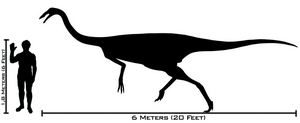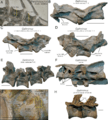Gallimimus facts for kids
Quick facts for kids GallimimusTemporal range: Upper Cretaceous
|
|
|---|---|
 |
|
| Gallimimus at the Natural History Museum | |
| Scientific classification | |
| Kingdom: | |
| Class: | |
| Superorder: | |
| Order: | |
| Suborder: | |
| Family: | |
| Genus: |
Gallimimus
|
| Species | |
|
|
Gallimimus (which means "chicken mimic") was a super fast-running dinosaur. It had a long, thin, flat, toothless beak, a small head, and a pretty big brain for its size. Gallimimus lived a long, long time ago, during the Upper Cretaceous period, about 75 to 70 million years ago.
What Did Gallimimus Look Like?
Gallimimus looked a lot like a modern ostrich. It had a small head, a beak without teeth, big eyes, a long neck, short arms, long legs, and a long tail. One special thing about Gallimimus was its very short "hand" bones compared to its upper arm bone. This is different from other dinosaurs in its family.
Its long tail helped it balance, especially when running fast. Its eyes were on the sides of its head, which meant it couldn't see things with both eyes at once (this is called binocular vision). Like most modern birds and other theropods, Gallimimus had hollow bones. This made them lighter and helped them move quickly.
Gallimimus had many features that suggest it was a great runner. These included a strong hip bone (called the ilium), a heavy tail base, long legs, and short toes. We don't know exactly how fast it could run, but it was likely very quick! All dinosaurs in the ornithomimid group had long skulls, but Gallimimus's snout was extra long. Young Gallimimus had shorter snouts.
Gallimimus in Movies
This amazing dinosaur appeared on the big screen in the famous movie Jurassic Park.
Images for kids
-
Cretaceous-aged dinosaur fossil localities of Mongolia; Gallimimus fossils were collected in area A
-
Life restoration showing an adult with feathers, based on those known from the related Ornithomimus
-
The beak of Gallimimus contained structures which have been compared to the lamellae of, for example, the Northern shoveller, or the ridges in the beaks of turtles and hadrosaurids
-
Skull cast of the juvenile specimen ZPAL MgD-I/1, National Museum of Natural History
See also
 In Spanish: Gallimimus bullatus para niños
In Spanish: Gallimimus bullatus para niños















